Computers and Electrical Engineering, vol. 47, issue October, Elsevier, pp. 299-317, 2015. DOI
Abstract
Current Critical Infrastructures (CIs) need intelligent automatic active reaction mechanisms to protect their critical processes against cyber attacks or system anomalies, and avoid the disruptive consequences of cascading failures between interdependent and interconnected systems. In this paper we study the Intrusion Detection, Prevention and Response Systems (IDPRS) that can offer this type of protection mechanisms, their constituting elements and their applicability to critical contexts. We design a methodological framework determining the essential elements present in the IDPRS, while evaluating each of their sub-components in terms of adequacy for critical contexts. We review the different types of active and passive countermeasures available, categorizing them and assessing whether or not they are suitable for Critical Infrastructure Protection (CIP). Through our study we look at different reaction systems and learn from them how to better create IDPRS solutions for CIP.
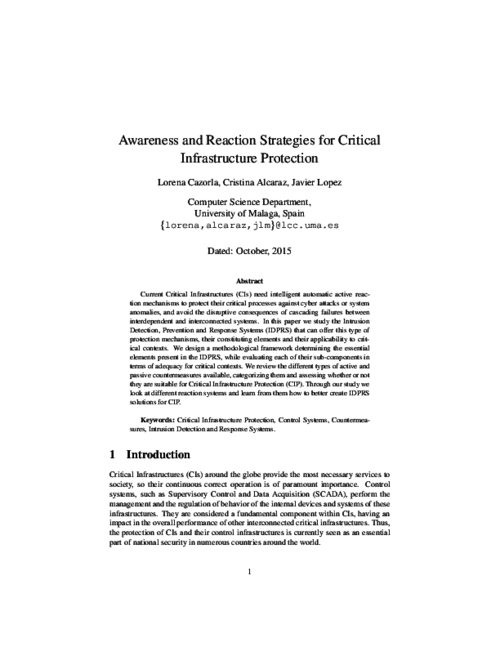
9th International Conference on Risks and Security of Internet and Systems , vol. 8924, Springer International Publishing, pp. 17-34, 04/2015. DOI
Abstract
Anomaly-based detection applied in strongly interdependent systems, like Smart Grids, has become one of the most challenging research areas in recent years. Early detection of anomalies so as to detect and prevent unexpected faults or stealthy threats is attracting a great deal of attention from the scientific community because it offers potential solutions for context-awareness. These solutions can also help explain the conditions leading up to a given situation and help determine the degree of its severity. However, not all the existing approaches within the literature are equally effective in covering the needs of a particular scenario. It is necessary to explore the control requirements of the domains that comprise a Smart Grid, identify, and even select, those approaches according to these requirements and the intrinsic conditions related to the application context, such as technological heterogeneity and complexity. Therefore, this paper analyses the functional features of existing anomaly-based approaches so as to adapt them, according to the aforementioned conditions. The result of this investigation is a guideline for the construction of preventive solutions that will help improve the context-awareness in the control of Smart Grid domains in the near future.
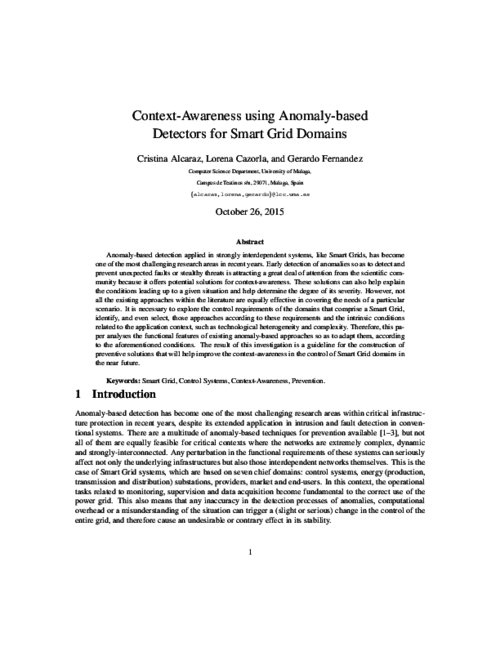
IEEE Systems Journal, vol. 12, issue 2, IEEE, pp. 1778-1792, 06/2018. DOI
Abstract
Current Critical Infrastructures (CIs) are complex interconnected industrial systems that, in recent years, have incorporated information and communications technologies such as connection to the Internet and commercial off-the-shelf components. This makes them easier to operate and maintain, but exposes them to the threats and attacks that inundate conventional networks and systems. This paper contains a comprehensive study on the main stealth attacks that threaten CIs, with a special focus on Critical Information Infrastructures (CIIs). This type of attack is characterized by an adversary who is able to finely tune his actions to avoid detection while pursuing his objectives. To provide a complete analysis of the scope and potential dangers of stealth attacks we determine and analyze their stages and range, and we design a taxonomy to illustrate the threats to CIs, offering an overview of the applicable countermeasures against these attacks. From our analysis we understand that these types of attacks, due to the interdependent nature of CIs, pose a grave danger to critical systems where the threats can easily cascade down to the interconnected systems.
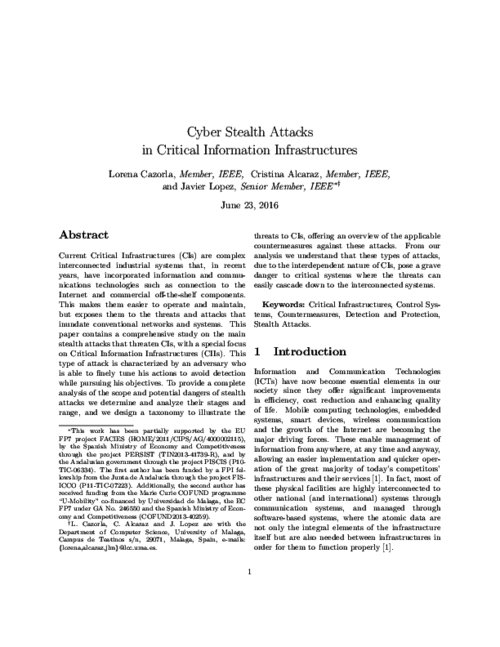
Cyber-Physical Systems: Foundations, Principles and Applications, no. Intelligent Data-Centric Systems, Academic Press, pp. 305 - 317, 2017. DOI
Abstract
Abstract Cyber-physical systems (CPSs), integrated in critical infrastructures, could provide the minimal services that traditional situational awareness (SA) systems demand. However, their application in SA solutions for the protection of large control distributions against unforeseen faults may be insufficient. Dynamic protection measures have to be provided not only to locally detect unplanned deviations but also to prevent, respond, and restore from these deviations. The provision of these services as an integral part of the SA brings about a new research field known as wide-area situational awareness (WASA), highly dependent on CPSs for control from anywhere across multiple interconnections, and at any time. Thus, we review the state-of-the art of this new paradigm, exploring the different preventive and corrective measures considering the heterogeneity of CPSs, resulting in a guideline for the construction of automated WASA systems.
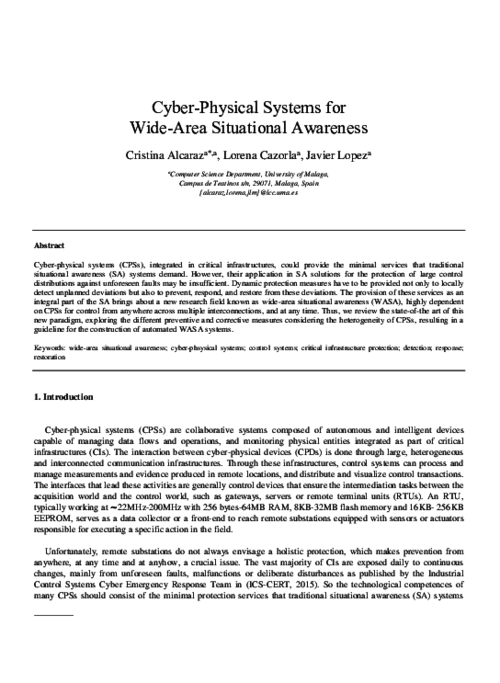
Computers & Security, vol. 55, no. November, Elsevier, pp. 235-250, 2015.
Abstract
The correct operation of Critical Infrastructures (CIs) is vital for the well being of society, however these complex systems are subject to multiple faults and threats every day. International organizations around the world are alerting the scientific community to the need for protection of CIs, especially through preparedness and prevention mechanisms. One of the main tools available in this area is the use of Intrusion Detection Systems (IDSs). However, in order to deploy this type of component within a CI, especially within its Control System (CS), it is necessary to verify whether the characteristics of a given IDS solution are compatible with the special requirements and constraints of a critical environment. In this paper, we carry out an extensive study to determine the requirements imposed by the CS on the IDS solutions using the Non-Functional Requirements (NFR) Framework. The outcome of this process are the abstract properties that the IDS needs to satisfy in order to be deployed within a CS, which are refined through the identification of satisficing techniques for the NFRs. To provide quantifiable measurable evidence on the suitability of the IDS component for a CI, we broaden our study using the Goal Question Metric (GQM) approach to select a representative set of metrics. A requirements model, refined with satisficing techniques and sets of metrics which help assess, in the most quantifiable way possible, the suitability and performance of a given IDS solution for a critical scenario, constitutes the results of our analysis.
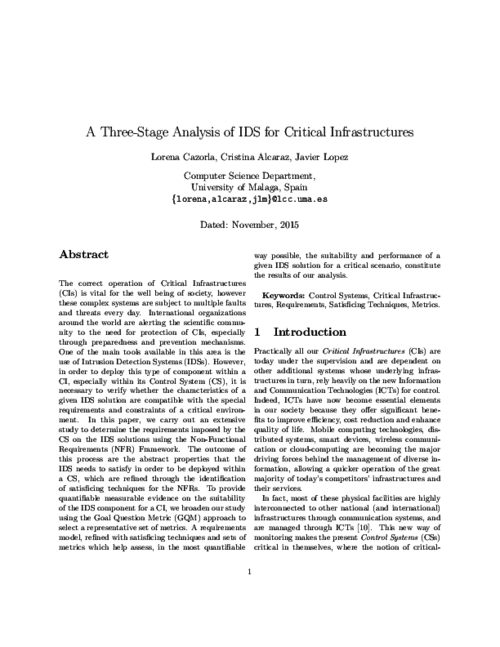
8th International Conference on Critical Information Infrastructures Security, vol. 8328, Springer, pp. 197-203, 2013. DOI
Abstract
Critical Infrastructure Protection (CIP) faces increasing challenges in number and in sophistication, which makes vital to provide new forms of protection to face every day’s threats. In order to make such protection holistic, covering all the needs of the systems from the point of view of security, prevention aspects and situational awareness should be considered. Researchers and Institutions stress the need of providing intelligent and automatic solutions for protection, calling our attention to the need of providing Intrusion Detection Systems (IDS) with intelligent active reaction capabilities. In this paper, we support the need of automating the processes implicated in the IDS solutions of the critical infrastructures and theorize that the introduction of Machine Learning (ML) techniques in IDS will be helpful for implementing automatic adaptable solutions capable of adjusting to new situations and timely reacting in the face of threats and anomalies. To this end, we study the different levels of automation that the IDS can implement, and outline a methodology to endow critical scenarios with preventive automation. Finally, we analyze current solutions presented in the literature and contrast them against the proposed methodology
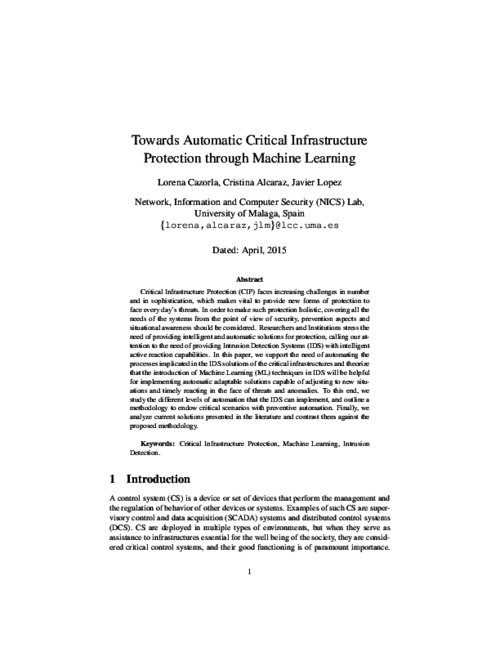
 ]
]